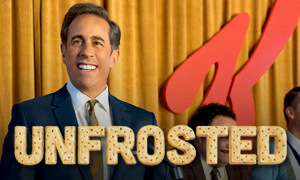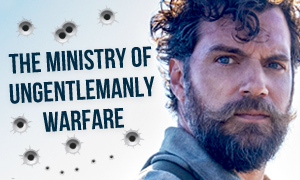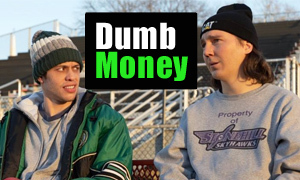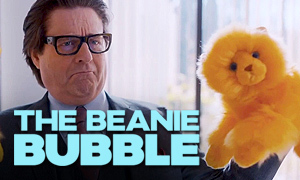Jerry and Marge Go Large: History vs. Hollywood
Bryan Cranston
Born: March 7, 1956
Birthplace:
Hollywood, California, USA
Jerry Selbee
Born: 1939
Birthplace: Michigan, USA
Annette Bening
Born: May 29, 1958
Birthplace:
Topeka, Kansas, USA
Marge Selbee
Rainn Wilson
Born: January 20, 1966
Birthplace:
Seattle, Washington, USA
Paul Mardas
Born: December 2, 1955
Birthplace: Springfield, Massachusetts, USA
Bio: Owner of Billy's Beverages | Renamed Bill in the Movie
Jake McDorman
Born: July 8, 1986
Birthplace:
Dallas, Texas, USA
Doug Selbee
Born: August 27, 1966
Birthplace: Michigan, USA
Anna Camp
Born: September 27, 1982
Birthplace:
Aiken, South Carolina, USA
Dawn Tomlinson
Born: abt 1957
Birthplace: Michigan, USA
When did the real-life story take place?
The Jerry and Marge Go Large true story reveals that while the Paramount+ movie is set in the present day, the real-life events began in 2003, which was the year that Jerry Selbee, then 64, figured out a loophole in a Michigan state lottery game called Winfall. He and his wife Marge, who live in the single-stoplight factory town of Evart, Michigan (population 1,900), spent roughly the next decade taking advantage of the game's mathematical flaw.
How long have Jerry and Marge Selbee been married?
In determining how accurate is Jerry and Marge Go Large, we confirmed that they were indeed high school sweethearts. Jerry and Marge Selbee were married on November 7, 1956 when Jerry was a high school senior. This is in line with the movie mentioning that they were married when they were 17. They celebrated their 65th wedding anniversary on November 7, 2021.
How old were the real Jerry and Marge Selbee when they started winning big?
Jerry and Marge were in their early sixties when Jerry, then 64, discovered the lottery loophole. This was not long after they had sold the local convenience store they had run for 17 years on Main Street in Evart, Michigan. Prior to purchasing the store in 1984, Jerry had been a materials analyst at a Kellogg's cereal factory, working on designing boxes and liners to maximize freshness. The movie has Bryan Cranston's character working at the cereal factory up until his retirement, omitting their ownership of the convenience store altogether.
Did it really take Jerry Selbee a matter of minutes to figure out the loophole in the lottery game?
Yes. In exploring the Jerry and Marge Go Large fact vs. fiction, we learned that on a random morning in 2003, Jerry walked into the convenience store he used to own. He noticed a brochure for a new state lottery game called Winfall. He read it, performed some quick lottery math, and says that in "three minutes," he "knew what the potential might be." -CBS News
What was Jerry Selbee's lottery loophole?
Jerry Selbee's lottery math involved a state lottery game in Michigan called Winfall. The unique thing about the game is that unlike Mega Millions where the jackpot keeps building until there's a winner, with Winfall, once the jackpot reached $5 million and no one matched all six numbers, the prize money rolled down to the lower-tier winners. When this occurred, it was called a "Rolldown" and the lottery commission announced in advance when it was going to happen. As a result, it would then significantly increase the winnings of people who matched five, four or three numbers.
Jerry calculated that if he spent $1,100 on tickets, odds are he'd have one four-number winner ($1,000) and 18 or 19 three-number winners that totaled $900. This meant that his investment of $1,100 would yield a $1,900 return, leaving him with a profit of $800. After Winfall was shut down in May 2005, Jerry Selbee applied his lottery strategy to a similar game in Massachusetts called Cash Winfall.
Does Jerry Selbee have a background in math?
Yes. In analyzing the Jerry and Marge Go Large fact vs. fiction, we discovered that Jerry has a bachelor's degree in math from Western Michigan University. Jerry Selbee called his lottery strategy "basic arithmetic" and was initially worried that a lot of other people would have figured the math out too, but he was "amazed" that was not the case. "I just couldn't fathom it," said Jerry. -CBS News
At what point did Jerry Selbee tell his wife Marge about his high-stakes gamble with their savings?
In answering the question, "Is Jerry and Marge Go Large accurate?" we confirmed that like in the movie, Jerry didn't tell marge until after he started testing out his lottery strategy. He waited for a rolldown to be announced and then he bought $3,600 in Winfall tickets and won $6,300. This confirmed his math. He then bought $8,000 worth of tickets and nearly doubled his money. It was at that point he thought it was a good time to tell his wife what he had been doing with their savings.
Did Jerry Selbee set up a corporation and invite family and friends to buy shares?
Yes. Jerry created the corporation G.S. Investment Strategies after he and Marge started betting hundreds of thousands of dollars. He invited family and friends to join the fund, which was similar to a hedge fund, and charged $500 per share. He detailed the corporation's winnings in stacks of record books and kept both the winning and losing tickets. He would meet with some of the members at a local Evart gathering place, Sugar Rae's Café, which closed a few years prior to the movie's release.
G.S. Investment Strategies members included James White, a local attorney; Dave Huff, a machine and tool shop operator; retired farmers Loren and Ray Gerber; three state troopers; a bank vice president; and a factory manager; to name a few. Huff says that the game helped him pay for his children's education, including one to go to law school. As of the spring of 2005, Jerry's gang had 25 members. Like in the movie, the Jerry and Marge Go Large true story confirms that a lot of townsfolk were leery of such a high-stakes gamble.
How many children do Jerry and Marge Selbee have?
Jerry and Marge have six children, 14 grandchildren, and 10 great-grandchildren. They reportedly invested some of their lottery winnings in their younger family members' educations.
Is Jerry and Marge Go Large based on a book?
The movie is actually based on Jason Fagone's 2018 Huffington Post article of the same name.
How much was Jerry Selbee's group betting and winning at its peak?
Jerry and his group of friends and family members were betting hundreds of thousands of dollars whenever a rolldown occurred in Michigan's Winfall lottery game and later in Massachusetts' Cash Winfall game. During an interview with CBS News, Jerry pointed out that during one such rolldown, for example, they purchased $515,000 in tickets and won $853,000, a 60 percent return.
Is Jerry Selbee's accountant, Steve, based on a real person?
Yes. Larry Wilmore's character, Steve Woods, was loosely inspired by Jerry Selbee's real-life accountant, Steve Wood, a longtime Evart local. Similar to what unfolds in the movie, Wood bought shares in the Selbees' corporation and used his winnings to go on four cruises and renovate his house. When the real events were taking place, Wood was similar in age to actor Larry Wilmore, 60. However, it seems that Steve Wood is white in real life, not black. The Huffington Post article also describes him as having a "smoker's scratchy voice."
How many times did Jerry's group play Michigan's Winfall lottery game?
A Jerry and Marge Go Large fact-check reveals that G.S. Investment Strategies played Winfall 12 times, accumulating over $2.6 million in winnings. When the Michigan game was shut down in the spring of 2005, they then played a similar Massachusetts game 43 times, racking up more than $24 million in winnings.
Did Jerry and Marge Selbee travel to Massachusetts to play a similar lottery game there?
Yes. Once the Winfall lottery game shut down in Michigan in 2005 due to, ironically, a lack of sales, Jerry and Marge Selbee began traveling 900 miles to Massachusetts to play a similar lottery game there called Cash Winfall. Jerry recalls, "One of our players emailed me and he said, 'Massachusetts has a game called Cash Winfall. Do you think we could play that?'" It took Jerry ten minutes to figure out that the game was another winner. In the movie, Jerry (Bryan Cranston) learns of the Massachusetts game from the local convenience store employee after he asks him why the Michigan game was shut down.
Jerry and Marge spent the next six years making the long trek to Massachusetts every time a rolldown happened in the game. On behalf of their corporation, they would make roughly seven plays per year, spending over $600,000 per play, a total expenditure of $4.2 million per year. They visited two convenience stores, purchased hundreds of thousands of tickets, and would hole up in a room at the Red Roof Inn (not the movie's fictional Pick and Shovel Motel), spending ten hours a day for ten days straight analyzing the tickets by hand for winners.
Is Rainn Wilson's character based on a real person?
Yes. As indicated at the top of the page, Rainn Wilson's character in the Jerry and Marge Go Large movie is based on Paul Mardas, the owner of Billy's Beverages in Sunderland, Massachusetts. The store was renamed Bill's Liquor Hut in the movie. Mardas shares a number of similarities with his onscreen counterpart, including being on the verge of a divorce when he met Jerry and Marge. The couple also offered him a stake in their corporation, which he accepted. Paul Mardas' lottery license was suspended in 2011 after he was accused of helping Jerry and Marge exploit the loophole in the Cash Winfall lottery game. Mardas has since remarried and has three stepchildren. -Huffington Post
Did a group of college students also discover the lottery loophole?
Yes, but the conflict with the college students in the movie is significantly exaggerated. In real life, after the closing of the Winfall lottery game in Michigan, the Selbee group began playing the Massachusetts lottery game Cash Winfall. They learned of a group of MIT students who were exploiting the same loophole in the game.
An MIT undergraduate named James Harvey, who was carrying out an independent study project for his mathematics degree, discovered the loophole and recruited a bunch of his friends to contribute money. He and his friend Yuran Lu formed the company Random Strategies Investments LLC to play Cash Winfall. Gradually, like the Selbees, they increased their money, got more backers, and were spending hundreds of thousands on tickets. Over a seven-year period, the MIT group saw the same rate of return as the Selbee gang, earning no less than $3.5 million in profits. -CBS News
Are the two Harvard students, Tyler and Eric, based on real people?
Comparing the Jerry and Marge Go Large fact vs. fiction reveals that the arrogant Harvard University students Tyler (Uly Schlesinger) and Eric (Cheech Manohar) are loosely based on James Harvey and Yuran Lu, who in real life attended MIT, not Harvard. Tyler and Eric's bullying tactics against the Selbees in the movie are pure Hollywood fiction, though the MIT group did intentionally trigger a rolldown.
Did the Selbees' high-volume ticket purchases lead to a government investigation?
Yes. In 2011, the Boston Globe learned via a tip that large volumes of Cash Winfall tickets were being sold in various Massachusetts locations. The Globe's Spotlight team, the same team that investigated the Catholic Church scandal, began looking into the suspicious bulk ticket purchases. They discovered that two groups, the Selbee gang from Michigan and a second group led by MIT math majors, were dominating the game.
The Globe's reporting caught the attention of state government officials, who suspected that the game might be rigged. Massachusetts State Inspector General Greg Sullivan headed up an investigation. "We used subpoenas, we looked at documents, we interviewed dozens of people to look at this in detail with a hypothesis that something illegal had happened." Like in the Jerry and Marge Go Large movie, the investigation concluded that everything the Selbee's team and the MIT group were doing was 100% legal and that no one's odds of winning were changed by the high-volume betting. What's not mentioned in the film is that the inspector general's report also identified other groups who exploited the loophole in the game, including a group of scientists from Boston University and Northeastern University (MIT.edu).
How much did Jerry and Marge Selbee win playing the lottery?
After exploiting the mathematical flaws in the lottery for almost a decade, their homegrown corporation made up of family and friends from around town had won $26.85 million from playing the Michigan lottery game Winfall 12 times and a similar game in Massachusetts called Cash Winfall 43 times. After Cash Winfall was shut down in 2012, the corporation had made a total of $7.75 million in profits from both games before taxes. In researching how accurate is Jerry and Marge Go Large, we learned that they only lost money in three of 55 drawings.
Did Jerry and Marge save all of their lottery tickets in case they were audited?
Yes. Like in the film, the real Jerry and Marge Selbee kept detailed records of their lottery transactions and winnings. The Jerry and Marge Go Large true story confirms that they kept $18 million worth of losing tickets in 60-65 large plastic totes that they stored in their barn in case of a federal audit. -CBS News
How did winning the lottery affect the real Jerry and Marge Selbee's lives?
"It didn't really affect our lives in any way other than giving us more financial security for our future," Jerry said. "Other members [of the corporation] buy a timeshare or take cruises. Marge and I didn't do any of that. We enjoyed life as it was." In addition to financial security, Jerry purchased a Ford F350 truck and a camping trailer. The Selbees also renovated their home and invested money in their grandkids' and great-grandkids' education.
Did Jerry use some of his winnings to start a construction loan business in the town of Evart?
This is what is stated at the end of the movie, and according to the Jerry and Marge Go Large true story, it's accurate. Jerry lent money for the construction of homes in the Traverse City area, focusing on housing for veterans, among others. -Huffington Post
Did Bryan Cranston and Annette Bening spend time with the Selbees prior to filming?
Yes. Actors Bryan Cranston and Annette Bening spent a few days with Jerry and Marge Selbee prior to filming. "When you're doing research like this, you just want to be open to receiving the essence of people that you're looking at," noted Cranston. They spent time with the married couple of more than 60 years doing normal things, including rocking away on the porch, going for a drive, and having a meal. "It was just really sweet." -LA Times
Does Jerry Selbee still play the lottery?
Yes, but only casually. He said that he continued to keep a close eye on the games, looking for a similar lottery loophole. He came across a game in Florida that he says is "similar but not quite the same. Winfall was a unique game. It was the only thing you could win without getting lucky, just based on purely mathematical and statistical odds." He will still purchase the occasional lottery ticket, particularly when there are large jackpots, but he doesn't spend over ten dollars.
Link-to-Learn More:







